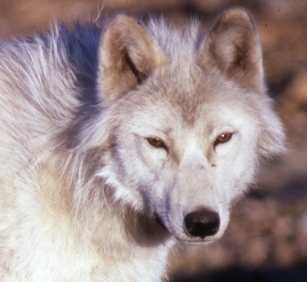
 |
|

Start Here: Predator/Prey -Predators-Prey Jump to:
Predator Module 1Predator Module 2Predator Module 3Download Entire Curriculum for Predator Download Dropbox and e-mail Dr. Packard to gain access to additional course materials |
Predator Inquiry: Why Care About Predator Social Behavior?
Nature's Partners:
Gaze into the eyes of a wolf, and what you see will depend on how much you have learned to care about predators. When our joys and fears are reflected in the eyes of other animals, we learn more about ourselves and the worlds around us. Behavior of our domestic dogs teach us how the canine mind differs from our own, encouraging us to learn to see our world through their eyes. Travelling backwards in time, we can better understand our dogs through the eyes of their ancestors, the wolves. Beyond that, we can better understand wolves by understanding behavior of their prey. For the most part, the general public is unaware of the similarities and differences between humans and other predators, or between the mentality of prey and their predators. The Nature's Partners: predators prey & you curriculum is designed to educate people about:
The Nature's Partners curriculum is just one step toward increasing the public's awareness and sense of responsibility. We have purposely chosen to focus on just two of the many predators and prey as a means for teaching basic concepts about behavior. Wolves were chosen because many of our families have first hand experience with dogs, the domesticated form of wolves. Elk were chosen because many outdoor enthusiasts have first hand experience with deer, plus the scientific information on elk is cutting-edge. On the left menu bar, we provide sources to background information on wolves and elk. We encourage you to research other predators and prey on the Internet, in your local library, and through your county office of the Cooperative Extension Service. Canids, both domestic dogs and native wolves, hunt herbivore prey in diverse habitats across America, from the frozen tundra to the sweltering mountain deserts. Worldwide, 36 of 278 carnivore species are dog-like. Other carnivore species include: cats (38), hyenas (4), mongooses (35), bears (8), true seals (19), walrus (1), raccoons (14), weasels (67), skunks (12), red pandas (1), civets (35) and Malagasy carnivores (8)[1]. Human societies across the globe share responsibility for solving problems caused by predator disease-transmission (such as rabies) and predation on vulnerable prey (such as stressed wildlife populations, livestock, pets, and even defenseless people)[2]. Better understanding of behavior is a key to positive problem-solving. For the U.S. Department of Agriculture, canids are not the only predators of concern to Wildlife Services, which is the federal agency responsible for protecting people, agriculture and wildlife3. The importance of these issues to society is reflected in the budget of $39 million allocated to Wildlife Services in 2008. Due to the high visibility of news releases about wildlife damage, much of the public is not aware of the positive influences of predators on the dynamic balance within ecosystems. Thanks to technological innovations, researchers are now learning that behaviors of predators and prey may have more indirect influence on the food web than the actual direct act of predation[3,4]. In the past, historical evidence led scientists to reject the overly simplistic hypothesis that predators always keep prey numbers in balance with their food resources. Recent evidence suggests that the relations among predators, prey and plants are more far-reaching, and more fascinating. For example, the absence of wolves from the Yellowstone ecosystem has been correlated with changes in growth of willows in the rivers where moose browsed and in aspen patches where elk grazed. Changes in the willow bushes may have influenced nesting populations of migratory songbirds. Return of the wolves influenced behavior of coyotes and cougars. In turn, coyotes have influenced behavior of foxes. In many ecosystems where large predators were exterminated to protect livestock, human hunters have taken over the role of keystone predator at the top of the trophic pyramid. A recent study published by the National Academy of Sciences[5] examines evidence that predation by humans is correlated with more rapid changes in the morphology and reproduction of prey in 40 ecosystems that included humans (compared to 20 control ecosystems where humans were excluded). The implications of this form of artificial selection on the gene pools of wild populations remains an intriguing puzzle for the next generation of budding young scientists. REFERENCES- FURTHER READING [1] "Animal Life", Edited by Dr. Charlotte Uhlenbrock, published by the American Museum of Natural History. View source details. [2] "Wolves of the World" International Wolf Center; "Terrestrial carnivores and human food production: impact and management." published by P.J. Baker et al.in 2008. Mammal Review vol. 38 pages 123-166. View report [3] Publications of the Predator Behavior & Ecology Project of the USDA National Wildlife Research Center View list [4] "Trophic downgrading of planet earth", By James A. Estes, et al. in 2011. Science 333, 301 DOI: 10.1126/science.1205106 [5] "Human predators outpace other agents of trait change in the wild", By Chris T. Darimont et. al.. Proceedings of the National Academy of Sciences. January 20, 2009 vol. 106 no. 3 pages 952-954 View report |
The information presented herein is for educational purposes only. Reference to commercial products or trade names is made with the understanding that
no discrimination is intended and no endorsement is implied. Unless otherwise noted, information provided by this page
does not represent the official views of Texas A&M University . |